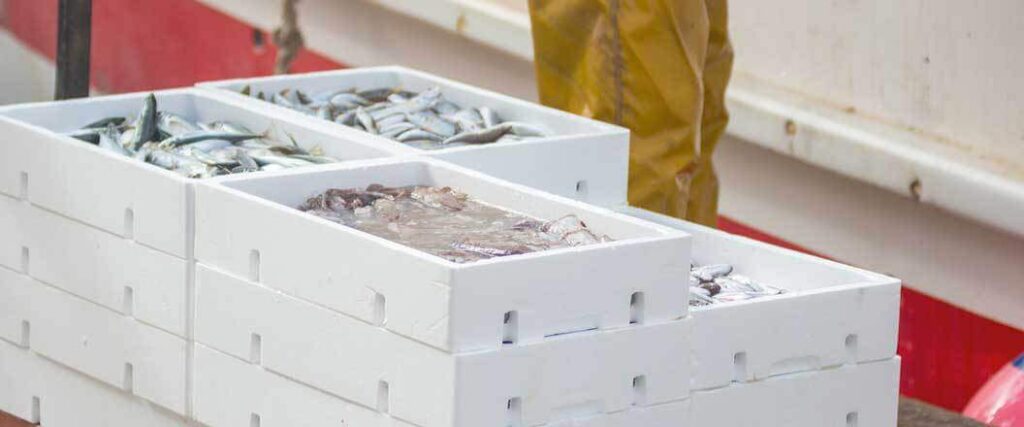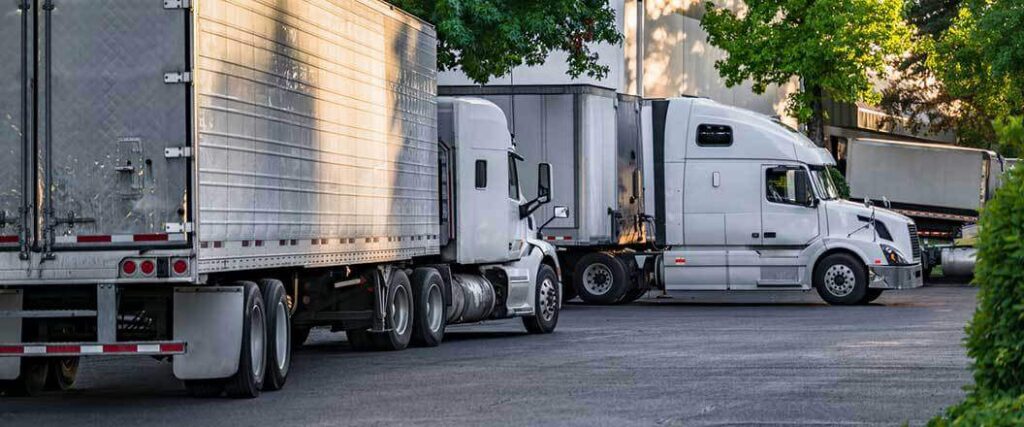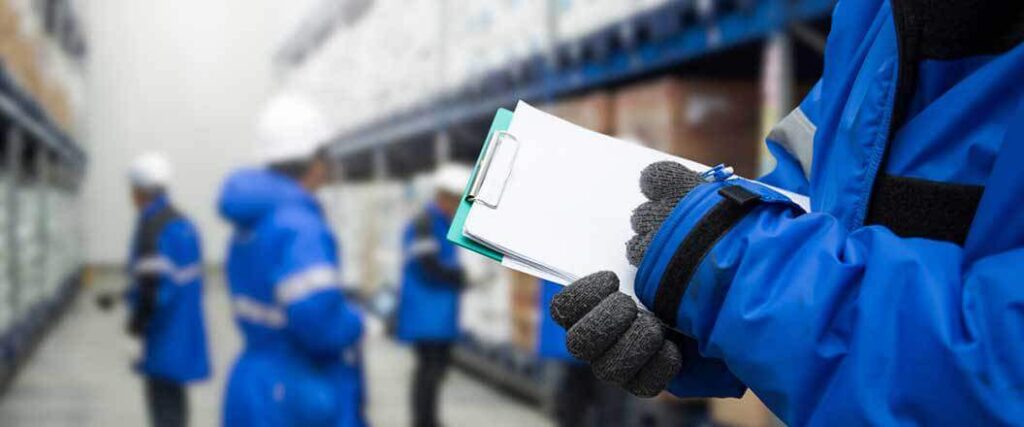What is cold chain distribution? Why is it so critically important? These and other questions help to define why cold chain distribution is such a booming industry. Cold chain distribution ensures that food and pharmaceutical products are available at the highest quality.
Cold chain distribution is the storage and distribution of temperature-controlled goods under specific regulations and in coordination with the Food and Drug Administration and the Global Cold Chain Alliance. Properly moving temperature-controlled cargo requires the proper equipment, research, and technological advancement to ensure the safe delivery of goods and adequate storage volume.
Moving items that require a consistent temperature to prevent spoilage or damage is no easy feat. Learn more about how to ship cold cargo today.
The cold chain, in simple terms, is the logistical management of perishable goods. This management of perishables starts with storing and transporting these goods to the point where they are consumed.
In other words, the cold chain is in place to ensure both the safety and quality of perishable items as they move from their point of origin to their final destination. The most significant area of importance within a cold chain is temperature management.
Managing the temperatures of perishable goods in a cold chain is critically important. According to the GCCA, temperature management dramatically reduces or eliminates the risk of bacteria or microbial growth. Failure to monitor and regulate temperatures can have a catastrophic effect on goods within the cold chain
The storage and management aspect of perishable goods is also not representative of the entire cold chain. There is also the shipping and distribution element added to the entire logistical pie: cold chain distribution.
A third-party logistics (3PL) partner can facilitate your cold chain needs with great care and ease to ensure your temperature-controlled good are taken care of from pickup to final delivery.

The process of cold distribution is when goods move along a cold chain from the point of pickup to the point of delivery. This system is the distribution method for any type of cargo requiring a consistent temperature.
Cold distribution is required to move temperature-regulated goods worldwide to facilitate cold manufactured goods. So there are two parts to the equation of cold chain distribution. There is the cold chain and cold distribution.
These two forms of logistics are what make up cold chain distribution. Another way to look at this is to call them management and transportation.
| Commodity | Market Share Percentage |
| Seafood | 23% |
| Dairy Products | 18% |
| Pharmaceuticals | 15% |
| Processed Food | 13% |
| Fruits and Vegetables | 10% |
| Other Items | 10% |
| Bakery & Confections | 6% |
| Fruit Pulp and Concentrates | 5% |
The breakdown of the cold chain distribution market share clearly illustrates the dominant goods that are moved along a cold chain for distribution worldwide. Pharmaceuticals and various foods are in the highest demand from a cold chain.
Cold chain is a critically important industry and means of distribution. In 2021 alone, the global market for cold chains was estimated to be valued at around 242 Billion worldwide. The cold chain market is expected to grow at a rate of 17% up to 2030.
There is a vital importance to the growing need for cold chain distribution as it directly relates to the fuel for humanity and the medicine to keep it thriving. At the same time, it is critical to consult with a specialist so you don’t violate any regulatory requirements.
The storage and transportation of pharmaceuticals from the point of manufacturing to a place of business is critical to maintaining a cold chain for both drug effectiveness and supply & demand.
The Food and Drug Administration (FDA) has particular regulations that outline cold chain industry requirements for pharmaceutical distribution. The FDA places responsibility on manufacturers and distributors to maintain adequate records for any pharmaceutical
Here are some examples of regulations dealing with pharmaceutical samples under the Code of Federal Regulations (CFR):
Although the temperature is crucially important, so is the science behind managing perishable goods, especially consumed goods. A definitive process of science and technology is the backbone of this method of storage and transport.
Under Title 21 of FDA regulations concerning refrigerated foods, temperatures should be relegated to 45 degrees Fahrenheit or less. This regulation is generalized and will vary depending on the foods in question.
Examples of FDA food distribution regulations:
Both of these regulations concern cold chain food distribution in the same way it concerns dry goods. The FDA is responsible for the safety of consumable goods regardless of whether they are perishable food or beverage; the same rules apply.
The Food Safety Inspection Service (FSIS), under the US Department of Agriculture (DOA), specifically regulates the storage and transportation of meat, poultry, eggs, and dairy products, due to possible contamination from microbial hazards resulting from pH levels in moisture.
The Hazard Analysis Critical Control Point (HACCP) system is in place to ensure proper handling, storage, and transportation. This system keeps cold chain food distribution from breaking, thus making food safe for consumption.
According to the Pan-American Health Organization (PAHO), cold chain vaccine distribution ensures proper storage, handling, and distribution of vaccines. This is accomplished through a network of refrigerated storage facilities and transports.
Through careful temperature management, vaccines must be regulated to temperatures between 35.6 degrees to 46.4 degrees Fahrenheit during both cold storage and transport.
However, certain vaccines that are made with viral strains are stored between 5 degrees to -13 degrees Fahrenheit. Besides these storage and transportation temperatures, the packaging for transport differs from temperature-controlled environments.
To maintain these regulated temperatures for vaccines, certain equipment is necessary. These items, such as cold storage containers, may or may not be temperature controlled. They will likely use cold plates, gel packs, or dry ice if they are not in a temperature-controlled container.

Cold chain products move goods along a vast interconnected global market. There are many different forms of refrigerated transport to help facilitate the movement of temperature-controlled perishables.
Commonly, the transportation people generally think of is refrigerated trucks. We see them daily on the streets and highways as they move about our communities. However, there are other forms of cold chain transportation.
Cold chain transportation methods:
These methods of transport are special in the fact that they are temperature control environments. For example, if you are transporting frozen food and shipping it from Florida to Georgia, a refrigerated truck will do just fine getting it there.
This example above really illustrates a short-range cold chain product distribution transport scenario. What if we are shipping diabetic insulin from a manufacturer in London, England, bound for St. Louis, Missouri?
The pharmaceuticals coming from Europe to the US will require a more elaborate method of cold shipping. Here is an example of the process:
This is a lengthy and intricate process when it involves vast distances. Also, this is an example of what’s known as transloading. This service is the fastest means of transportation and utilizes multiple modes of shipping by keeping flexibility.

A cold chain is maintained through the use of several advanced technologies and moving parts throughout the process of moving goods worldwide. It takes incredible know-how, precision, and research to pull it off daily.
While issues can pop up during the process, it takes a team and, more importantly, a service that knows how to maintain a cold chain and tackle any problems that may occur during the cold chain distribution process.
Issues stemming from improperly filed paperwork leading to improperly set temperatures can prove to be highly problematic. Both improper packaging and transportation delays are fundamental challenges when maintaining a cold chain.
These challenges and issues can be avoided with the aid of cold chain logistics companies. The concept of cold chain logistics covers two major overarching components. These components are an essential part of what keeps a cold chain maintained.
As you can see, maintaining a cold chain in the distribution has a wide array of moving parts and tools that are required to make it all function. Any breakdown in this process can prove catastrophic.
Strict attention to detail is required at all times, including a vast knowledge of what is being shipped, what temperature to ship it at, and how it is to be handled along the way. A proven cold chain is needed to effectively move perishable goods, like pharmaceuticals and food.
Cold chain warehousing is a critical aspect of cold supply chain management and distribution because maintaining available volume is the key to sustaining the needs of consumers. The flow from these cold storage facilities is equally critical as well.
So what does this mean exactly? Basically, there is a constant need for goods stored in a refrigerated setting that are readily available. In other words, when a pharmacy runs out of insulin, they need to be able to call up a replacement supply.
By storing refrigerated volumes at a cold storage facility, goods can be replenished without needing to depend on manufacturing. This is why cold storage capacity increases annually, and the U.S. leads North America in cold storage capacity.
| Country | Capacity Percentage |
| United States | 84% |
| Mexico | 10% |
| Canada | 6% |
These storage facilities maintain cold and freezer storage solutions. Cold storage goods like meats, fruits, and vegetables could be kept above freezing. Then other goods which require freezing temperatures can be sorted in freezer storage solutions.
Freezer storage solutions are critical for goods with consistent temperatures that do not fluctuate. Pharmaceuticals are among the most essential goods which require consistent temperature control so they do not go bad during storage or transport.
When shipping temperature sensitive products like food and pharmaceuticals, it is crucial to have the appropriate packaging systems in place to store and ship them. There are three packing systems designed to accommodate temperature-controlled shipping.
The three packaging systems are:
There are various pros and cons to each system, as well as use cases. Active systems have the highest reliability and cost of the three, while hybrid systems have a more moderate cost and temperature accuracy. Passive systems, however, are cheaper and less reliable.
Fortunately, when dealing with a cold chain distribution partner like USA Refrigerated Freight. You can ensure and trust that you are using the preferred solution for your freight. It is vital to ship temperature-controlled goods using the proper means every time.
When shipping temperature-controlled goods near or far, between states, or internationally, cold chain distribution is the answer. And who better to facilitate your cold shipping needs than the industry standard USA Refrigerated Freight?
Our vast cold storage, shipping, and distribution network will ensure that you never skip a beat and consistently beat the heat. Our dedicated and experienced professionals are standing by to help get your business on the right track.
Our industry professionals will freeze the competition with the latest and best technologies, storage solutions, and the fastest and most accurate distribution methods. Call us at 866-849-4923 or click today to consult with a specialist and get started today.
USA Refrigerated Freight
315 NE 14th Street #4122
Ocala, FL 34470